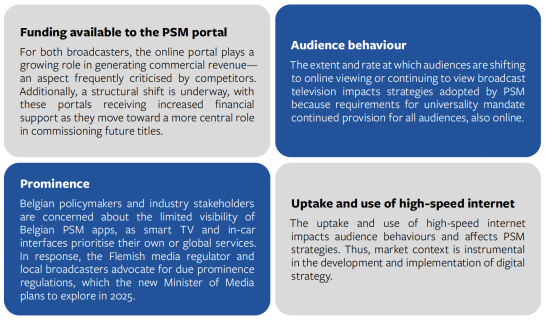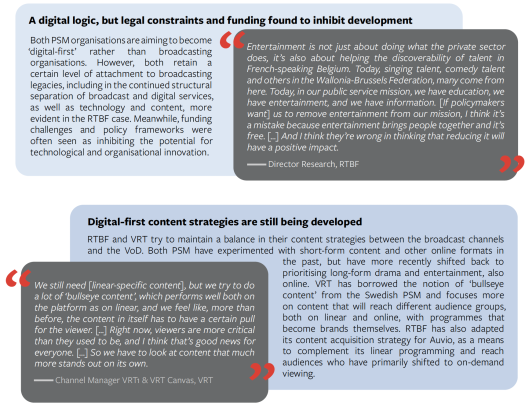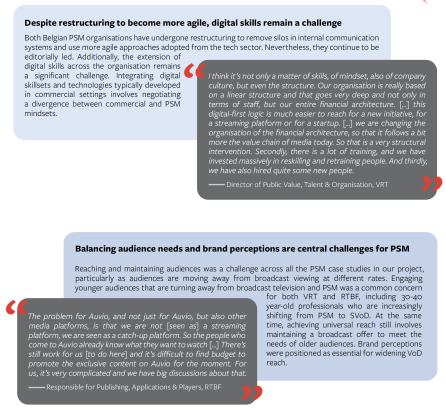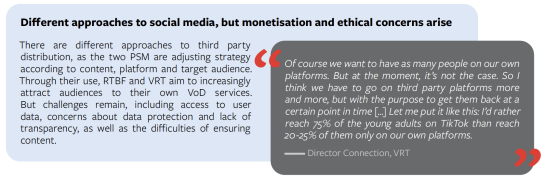27 March 2025
Catalina Iordache and Tim Raats
https://doi.org/10.48785/100/322 1
Public service media (PSM) worldwide have consistently been subject to societal and technological changes. Recent years have confronted PSM with radical transformations in media use, competition with transnational streaming services, and the dominance of big tech. New competitors for the attention of citizens have challenged both the PSM mission and values as well as the organisation, requiring broadcasters to transform into fully digital, online-first organisations. In this context, we present results from research conducted during the second year of PSM-AP, a large-scale comparative research project analysing ‘Public Service Media in the Age of Platforms’. In this brief, we put forward a series of findings and recommendations on the organisational and cultural challenges facing PSM in the two main language communities of Belgium. This report is based on in-depth interviews with employees (top and middle management, conducted in May-August 2024) in two PSM organisations: RTBF (French-speaking Community of Belgium) and VRT (Dutch-speaking Community). The collected data was analysed in line with country-specific organisational reports and industry documents.
Transforming PSM Organisations in the Age of Platforms
The transformation of the media ecosystem, dominated by technology giants such as Netflix, Apple, Alphabet and Amazon, challenges the established operating practices and organisational structures of PSM. Both RTBF and VRT are increasingly shifting towards internet-delivered television through their video-on-demand services. Our study suggests that this requires the PSM organisations to transform their operating practices, including integrating digital tools and personnel with digital skills. Structures and cultures rooted in the broadcast context challenge this adaptation, particularly in the face of departmentalisation, bureaucracy, and silo-based communications inherited from the past. Both RTBF and VRT indicate that their developing digital strategies prioritise responding to different audience needs and managing brand perceptions. These efforts are also leading to shifts in commissioning and distribution strategies. Moreover, they need to be navigated in relation to extant public service remits and obligations set out in policy.
Despite these shared concerns, the trajectory towards online-only delivery varied for the two PSM organisations in Belgium. Generally, their transition towards digital-first is more incremental than other cases in our project, such as Denmark and the UK. However, the VRT MAX service is increasingly discussed as the ‘front door’ to all VRT content, and its role in the companywide strategy is visibly growing. For RTBF, the image of RTBF Auvio as essentially a catch-up service remains difficult to alter with audiences, and the wider reach on linear limits the resources invested in the VoD service.
Our study identified four key factors that are shaping the ways in which the rise of internet delivery and competition from streamers is managed within the Belgian PSM organisations.

Key findings



Recommendations
| Policymakers need to create regulatory and organisational regimes that enable PSM to innovate without diluting their core principles and values to citizens. PSM should be able to respond quickly to emerging technological trends, with sufficient financial support and forward-looking policy frameworks. |
| Flatter organisational structures and greater integration of technology and digital skills are required for PSM to adapt to the challenges of the platform age. Organisational change must be accompanied by a shift in organisational culture thinking and greater integration of digital skills across the workforce. |
| In an increasingly competitive online media context, brand perceptions of PSM are crucial for its future legitimacy. PSM organisations need to effectively communicate their brand values, including that of the VoD portal, across multigenerational and diverse audiences. Ensuring sufficient independence from political interference (EMFA implementation in the EU context) and clear accountability to the public are both essential to securing and maintaining trust in PSM brands. |
| There is no ‘one-size-fits-all’ solution, as the balance between broadcasting and digital commissioning and distribution is highly context-specific. There is the risk that commissioning fewer/bigger titles will reduce the range and diversity of PSM content which could also diminish the ability to serve the needs of all audiences. Moreover, there is a need for clear Key Performance Indicators to define and measure success and these should be clearly aligned with PSM remits, also when it comes to assessing the VoD service. Among the critical factors for PSM success is to emphasise and engage with the audience’s digital and civic literacies. |
| Regulation needs to address the distribution of PSM content on third-party platforms, especially social media platforms that may become the first ‘point of reference’ for younger audiences. Policymakers should explore interventions to facilitate the development of cooperative frameworks for the distribution of PSM content on social media, particularly in relation to PSM content integrity and visibility, as well as data sharing, data protection and monetisation. |
About the project
PSM-AP is a three-year research project that examines how public service media organisations, regulators and policymakers are adapting to the new platform age. The project is supported by the CHANSE ERA-NET co-fund programme, which has received funding from the European Union’s Horizon 2020 Research and Innovation Programme, under Grant Agreement no 101004509. PSMAP is led by Catherine Johnson (University of Leeds, UK), together with Principal Investigators Tim Raats (Vrije Universiteit Brussel, BE), Michał Głowacki (University of Warsaw, PL), Hanne Bruun (Aarhus University, DK), co-investigator Massimo Scaglioni (Università Cattolica del Sacro Cuore, IT), together with postdoctoral researchers Catalina Iordache (Vrije Universiteit Brussel, BE), Dan Martin (University of Leeds, UK), Julie Mejse Münter Lassen (Aarhus University, DK), Filip Świtkowski (University of Warsaw, PL), Antonio Nucci (Università Cattolica del Sacro Cuore, IT), and supporting researchers Jacek Mikucki (University of Warsaw, PL) and Katarzyna Gajlewicz-Korab (University of Warsaw, PL). More information on the project can be found here: https://psm-ap.com/



